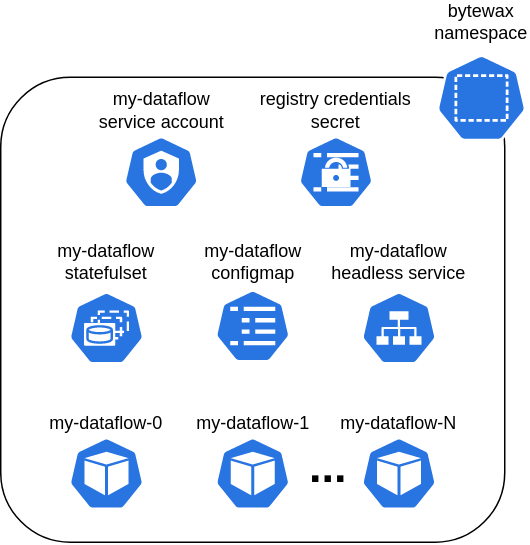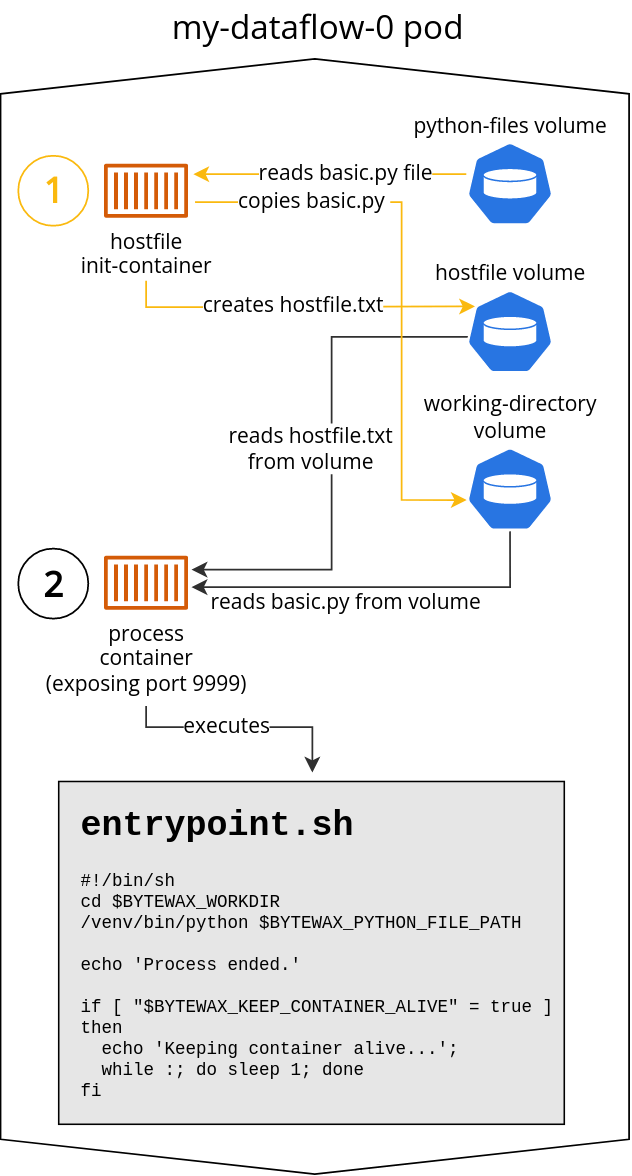Helm Chart#
As we mentioned in our Starting a Cluster of Processes. Bytewax allows you to run a dataflow program in a coordinated set of processes.
That entry point requires the addresses of all the processes and assign them each a unique ID.
Our Kubernetes implementation is coupled with
bytewax.parse.proc_env() function which looks for some specific
environments variables to fill the needed arguments of
bytewax.cluster_main().
We modeled the following Kubernetes ecosystem to run a Bytewax dataflow with one or more processes involved.
Kubernetes Resources#
This diagram shows which Kubernetes resources are included in our stack.

We are going to cover each resource by explaining how we use them to run a Bytewax dataflow:
Namespace#
A Bytewax dataflow stack can be deployed in any namespace but it is recommended that it is installed in a dedicated one to leverage Namespace isolation characteristics about security and resource designation.
Dataflow StatefulSet#
Bytewax uses a StatefulSet object to manage workloads in Kubernetes because a unique and stable network identifier for each Pod is required (stable means that a Pod is going to keep its name across Pod (re)scheduling) and StatefulSets meet this requirement.
Because each Pod in a StatefulSet derives its hostname from the name of the StatefulSet and the ordinal of the Pod, we can have an Init-Container which dynamically generates the needed list of addresses and stores them in a file in a volume which will be mounted by the application container.
Also, we use the ordinal of each Pod as the unique ID needed for each process.
For example, assuming that we are running a dataflow named
my-dataflow with three processes in a namespace called bytewax we
are going to have these pods:
my-dataflow-0
my-dataflow-1
my-dataflow-2
And their network addresses are going to be:
my-dataflow-0.my-dataflow.bytewax.svc.cluster.local:9999
my-dataflow-1.my-dataflow.bytewax.svc.cluster.local:9999
my-dataflow-2.my-dataflow.bytewax.svc.cluster.local:9999
As you can see we use the port 9999 to expose each process.
Leveraging the Kubernetes naming convention for Pods and their DNS we automated the stack configuration.
Another important aspect of each Pod configuration is that the
application container also mounts another volume called
working-directory. This is going to have a ConfigMap that we will
cover later, but basically this has the python file and any other
files required to run successfully.
In this image we show how the init-container and the application container of the Pods work together:

The hostfile init-container stores a file named hostfile.txt with
all the addresses of the processes, and the application container
process reads that file (in fact, bytewax.parse.proc_env() does
that work).
Also, the image shows that the init-container is reading the content
of the ConfigMap mounted in the python-files volume and copying that
to the working-directory volume. In the example the content of the
ConfigMap is a file named basic.py. In the ConfigMap section we are
going to talk more about that.
Environment Variables in the Application Container#
In the above diagram, the application container has these environment variables:
- name: BYTEWAX_IMPORT_STR
value: basic:flow
- name: BYTEWAX_WORKDIR
value: /var/bytewax
- name: BYTEWAX_WORKERS_PER_PROCESS
value: "1"
- name: BYTEWAX_POD_NAME
valueFrom:
fieldRef:
apiVersion: v1
fieldPath: metadata.name
- name: BYTEWAX_REPLICAS
value: "3"
- name: BYTEWAX_KEEP_CONTAINER_ALIVE
value: "true"
- name: BYTEWAX_HOSTFILE_PATH
value: /etc/bytewax/hostfile.txt
- name: BYTEWAX_STATEFULSET_NAME
value: my-dataflow
Some of those were already covered in the How The Bytewax Image works section.
The environment variables can be grouped into two groups:
Environments Variables used in entrypoint.sh script:#
BYTEWAX_IMPORT_STR: path of the python script to run.BYTEWAX_WORKDIR: working directory with all the ConfigMap content.BYTEWAX_KEEP_CONTAINER_ALIVE: if is set totrue, after the dataflow program ends an infinite loop is going to keep the container running.
Environments Variables internally used by Bytewax when parse.proc_env() is called:#
BYTEWAX_HOSTFILE_PATH: path of the file that has all the processes addresses.BYTEWAX_POD_NAME: name of the current Pod used to get the ordinal of it.BYTEWAX_REPLICAS: number of processes running in the Bytewax cluster.BYTEWAX_STATEFULSET_NAME: name of the StatefulSet used to get the ordinal of the current Pod.BYTEWAX_WORKERS_PER_PROCESS: number of workers triggered by each process.
Security Configuration#
Our StatefulSet Pod template definition has strict Pod and Container security context settings. These are the most important aspects:
The container user is not root and can’t escalate.
All the filesystems are read-only except the
working-directoryvolume.The only Linux Capability enabled is
NET_BIND_SERVICE.
Headless service#
This is a Kubernetes Service without an assigned IP only used to interface with Kubernetes’ service discovery mechanisms.
For Bytewax we use the service to instruct Kubernetes to create an endpoint for each Pod in our Statefulset. In this way, there will be a known DNS entry for each process in the Bytewax cluster.
ConfigMap#
We stored the python script file and every needed file in a ConfigMap.
The content of that ConfigMap is mounted in the working-directory
volume in the BYTEWAX_WORKDIR path with read-write access. This
strategy allows us to:
Decouple the container image from the Python code to run.
Set strong security filesystem configurations setting the filesystems to read-only except for the working directory.
Storing a tree of files and directories#
Sometimes your python script will need some input extra files to work with. In that case, we have implemented an approach that involves creating a tar file including all the files/directories needed and then storing that tarball in the ConfigMap.
In that scenario we use some extra steps in our init-container. You can read more about that in our Helm Chart repository.
Registry Credentials Secret#
In the case that the container image is stored in a private registry, this secret will contain the credentials needed to pull images from that registry.
Service Account#
We use this Kubernetes object to give access to the Registry Credentials Secrets mentioned above to the StatefulSet Pods.
Next Steps#
If you want to deploy this stack in your Kubernetes cluster we invite you to read our section Using waxctl to Run your Dataflow on Kubernetes where we use the Bytewax CLI, Waxctl, to do that.
Example Manifests#
The manifests for the above example
As you can see, we rely on Helm to generate our manifests. You can read more about our Helm Chart here.
---
apiVersion: v1
kind: Namespace
metadata:
annotations:
meta.helm.sh/release-name: my-dataflow
meta.helm.sh/release-namespace: bytewax
labels:
app.kubernetes.io/instance: my-dataflow
app.kubernetes.io/managed-by: Helm
app.kubernetes.io/name: bytewax
bytewax.io/managed-by: waxctl
kubernetes.io/metadata.name: bytewax
name: bytewax
spec:
finalizers:
- kubernetes
---
apiVersion: v1
data:
basic.py: |
import bytewax.operators as op
from bytewax.connectors.stdio import StdOutSink
from bytewax.dataflow import Dataflow
from bytewax.testing import TestingSource
def double(x: int) -> int:
return x * 2
def halve(x: int) -> int:
return x // 2
def minus_one(x: int) -> int:
return x - 1
def stringy(x: int) -> str:
return f"<dance>{x}</dance>"
flow = Dataflow("basic")
inp = op.input("inp", flow, TestingSource(range(10)))
branch = op.branch("e_o", inp, lambda x: x % 2 == 0)
evens = op.map("halve", branch.trues, halve)
odds = op.map("double", branch.falses, double)
combo = op.merge("merge", evens, odds)
combo = op.map("minus_one", combo, minus_one)
string_output = op.map("stringy", combo, stringy)
op.output("out", string_output, StdOutSink())
kind: ConfigMap
metadata:
annotations:
meta.helm.sh/release-name: my-dataflow
meta.helm.sh/release-namespace: bytewax
labels:
app.kubernetes.io/instance: my-dataflow
app.kubernetes.io/managed-by: Helm
app.kubernetes.io/name: bytewax
bytewax.io/managed-by: waxctl
name: my-dataflow
namespace: bytewax
---
apiVersion: apps/v1
kind: StatefulSet
metadata:
annotations:
meta.helm.sh/release-name: my-dataflow
meta.helm.sh/release-namespace: bytewax
generation: 2
labels:
app.kubernetes.io/instance: my-dataflow
app.kubernetes.io/managed-by: Helm
app.kubernetes.io/name: bytewax
app.kubernetes.io/version: 0.8.0
bytewax.io/managed-by: waxctl
helm.sh/chart: bytewax-0.2.3
name: my-dataflow
namespace: bytewax
spec:
podManagementPolicy: Parallel
replicas: 3
revisionHistoryLimit: 10
selector:
matchLabels:
app.kubernetes.io/instance: my-dataflow
app.kubernetes.io/name: bytewax
serviceName: my-dataflow
template:
metadata:
creationTimestamp: null
labels:
app.kubernetes.io/instance: my-dataflow
app.kubernetes.io/name: bytewax
spec:
containers:
- command:
- sh
- -c
- sh ./entrypoint.sh
env:
- name: RUST_LOG
value: librdkafka=debug,rdkafka::client=debug
- name: RUST_BACKTRACE
value: full
- name: BYTEWAX_PYTHON_FILE_PATH
value: /var/bytewax/basic.py
- name: BYTEWAX_WORKDIR
value: /var/bytewax
- name: BYTEWAX_WORKERS_PER_PROCESS
value: "1"
- name: BYTEWAX_POD_NAME
valueFrom:
fieldRef:
apiVersion: v1
fieldPath: metadata.name
- name: BYTEWAX_REPLICAS
value: "3"
- name: BYTEWAX_KEEP_CONTAINER_ALIVE
value: "true"
- name: BYTEWAX_HOSTFILE_PATH
value: /etc/bytewax/hostfile.txt
- name: BYTEWAX_STATEFULSET_NAME
value: my-dataflow
image: bytewax/bytewax:latest
imagePullPolicy: Always
name: process
ports:
- containerPort: 9999
name: process
protocol: TCP
resources: {}
securityContext:
allowPrivilegeEscalation: false
capabilities:
add:
- NET_BIND_SERVICE
drop:
- ALL
readOnlyRootFilesystem: true
terminationMessagePath: /dev/termination-log
terminationMessagePolicy: File
volumeMounts:
- mountPath: /etc/bytewax
name: hostfile
- mountPath: /var/bytewax/
name: working-directory
dnsPolicy: ClusterFirst
imagePullSecrets:
- name: default-credentials
initContainers:
- command:
- sh
- -c
- |
set -ex
# Generate hostfile.txt.
echo "my-dataflow-0.my-dataflow.bytewax.svc.cluster.local:9999" > /etc/bytewax/hostfile.txt
replicas=$(($BYTEWAX_REPLICAS-1))
x=1
while [ $x -le $replicas ]
do
echo "my-dataflow-$x.my-dataflow.bytewax.svc.cluster.local:9999" >> /etc/bytewax/hostfile.txt
x=$(( $x + 1 ))
done
# Copy python files to working directory
cp /tmp/bytewax/. /var/bytewax -R
cd /var/bytewax
tar -xvf *.tar || echo "No tar files found."
env:
- name: BYTEWAX_REPLICAS
value: "3"
image: busybox
imagePullPolicy: Always
name: init-hostfile
resources: {}
securityContext:
allowPrivilegeEscalation: false
capabilities:
add:
- NET_BIND_SERVICE
drop:
- ALL
readOnlyRootFilesystem: true
terminationMessagePath: /dev/termination-log
terminationMessagePolicy: File
volumeMounts:
- mountPath: /etc/bytewax
name: hostfile
- mountPath: /var/bytewax/
name: working-directory
- mountPath: /tmp/bytewax/
name: python-files
restartPolicy: Always
schedulerName: default-scheduler
securityContext:
fsGroup: 2000
runAsGroup: 3000
runAsNonRoot: true
runAsUser: 65532
serviceAccount: my-dataflow-bytewax
serviceAccountName: my-dataflow-bytewax
terminationGracePeriodSeconds: 10
volumes:
- emptyDir: {}
name: hostfile
- configMap:
defaultMode: 420
name: my-dataflow
name: python-files
- emptyDir: {}
name: working-directory
updateStrategy:
rollingUpdate:
partition: 0
type: RollingUpdate
---
apiVersion: v1
kind: Service
metadata:
annotations:
meta.helm.sh/release-name: my-dataflow
meta.helm.sh/release-namespace: bytewax
labels:
app.kubernetes.io/instance: my-dataflow
app.kubernetes.io/managed-by: Helm
app.kubernetes.io/name: bytewax
app.kubernetes.io/version: 0.8.0
bytewax.io/managed-by: waxctl
helm.sh/chart: bytewax-0.2.3
name: my-dataflow
namespace: bytewax
spec:
clusterIP: None
clusterIPs:
- None
ipFamilies:
- IPv4
ipFamilyPolicy: SingleStack
ports:
- name: worker
port: 9999
protocol: TCP
targetPort: 9999
selector:
app.kubernetes.io/instance: my-dataflow
app.kubernetes.io/name: bytewax
sessionAffinity: None
type: ClusterIP
---
apiVersion: v1
imagePullSecrets:
- name: default-credentials
kind: ServiceAccount
metadata:
annotations:
meta.helm.sh/release-name: my-dataflow
meta.helm.sh/release-namespace: bytewax
labels:
app.kubernetes.io/instance: my-dataflow
app.kubernetes.io/managed-by: Helm
app.kubernetes.io/name: bytewax
app.kubernetes.io/version: 0.8.0
bytewax.io/managed-by: waxctl
helm.sh/chart: bytewax-0.2.3
name: my-dataflow-bytewax
namespace: bytewax
secrets:
- name: my-dataflow-bytewax-token-2nnxc